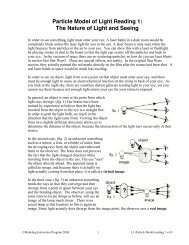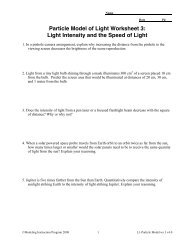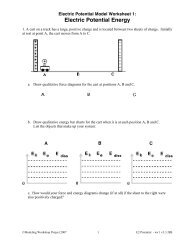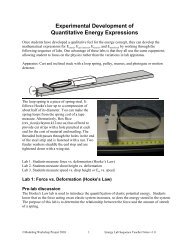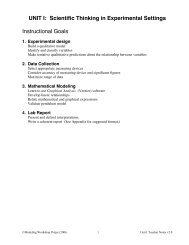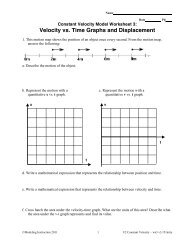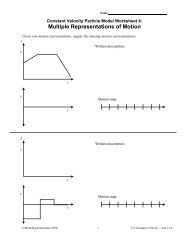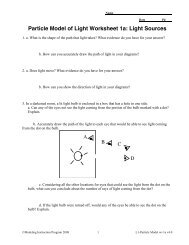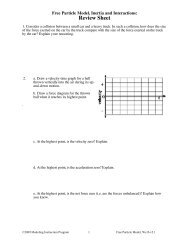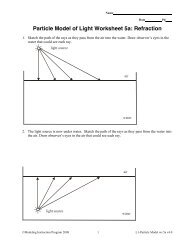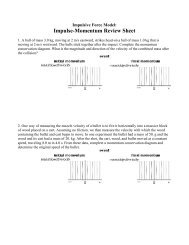Lab Extension: Increasing and Decreasing Speed - Modeling Physics
Lab Extension: Increasing and Decreasing Speed - Modeling Physics
Lab Extension: Increasing and Decreasing Speed - Modeling Physics
You also want an ePaper? Increase the reach of your titles
YUMPU automatically turns print PDFs into web optimized ePapers that Google loves.
Uniformly Accelerated Particle Model<strong>Lab</strong> <strong>Extension</strong>: <strong>Increasing</strong> <strong>and</strong> <strong>Decreasing</strong> <strong>Speed</strong>1. <strong>Increasing</strong> speed in the positive directiona. Without using the motion detector, observe the motion of the cart as it starts from rest <strong>and</strong> rollsdown the incline.b. Draw a motion map. Include velocity <strong>and</strong> acceleration vectors.c. Is the velocity positive or negative? d. Is the acceleration positive or negative?e. Predict the graphs describingthe motion.f. Record the graphs as displayedby the motion detector.g. The slope of theposition-time graph is(constant / increasing / decreasing)<strong>and</strong>(positive / negative)<strong>and</strong> represents______________________.h. The slope of thevelocity-time graph is(constant / increasing / decreasing)<strong>and</strong>(positive / negative)<strong>and</strong> represents______________________.©<strong>Modeling</strong> Instruction Program 2009 1 Uniformly Accelerated Particle Model
2. <strong>Decreasing</strong> speed in the positive directiona. Without using the motion detector, observe the motion of the cart slowing after an initial push.Answer the following questions for the cart while coasting.b. Draw a motion map including both velocity <strong>and</strong> acceleration vectors.c. Is the velocity positive or negative? d. Is the acceleration positive or negative?e. Predict the graphs describingthe motion.f. Record the graphs as displayedby the motion detector.g. The slope of theposition-time graph is(constant / increasing / decreasing)<strong>and</strong>(positive / negative)<strong>and</strong> represents______________________.h. The slope of thevelocity-time graph is(constant / increasing / decreasing)<strong>and</strong>(positive / negative)<strong>and</strong> represents______________________.©<strong>Modeling</strong> Instruction Program 2009 2 Uniformly Accelerated Particle Model
3. <strong>Increasing</strong> speed in the negative directiona. Observe the motion of the cart starting from rest <strong>and</strong> rolling down the incline without using themotion detector.b. Draw a motion map including both velocity <strong>and</strong> acceleration vectors.c. Is the velocity positive or negative? d. Is the acceleration positive or negative?e. Predict the graphs describing themotion.f. Record the graphs as displayedby the motion detector.g. The slope of theposition-time graph is(constant / increasing / decreasing)<strong>and</strong>(positive / negative)<strong>and</strong> represents______________________.h. The slope of thevelocity-time graph is(constant / increasing / decreasing)<strong>and</strong>(positive / negative)<strong>and</strong> represents______________________.©<strong>Modeling</strong> Instruction Program 2009 3 Uniformly Accelerated Particle Model
4. <strong>Decreasing</strong> speed in the negative directiona. Observe the motion of the cart slowing after an initial push without using the motion detector.Answer the following questions for the cart while coasting.b. Draw a motion map including both velocity <strong>and</strong> acceleration vectors.c. Is the velocity positive or negative? d. Is the acceleration positive or negative?e. Predict the graphs describingthe motion.f. Record the graphs as displayedby the motion detector.g. The slope of theposition-time graph is(constant / increasing / decreasing)<strong>and</strong>(positive / negative)<strong>and</strong> represents______________________.h. The slope of thevelocity-time graph is(constant / increasing / decreasing)<strong>and</strong>(positive / negative)<strong>and</strong> represents______________________.©<strong>Modeling</strong> Instruction Program 2009 4 Uniformly Accelerated Particle Model
5. Up <strong>and</strong> down the rampa. Observe the motion of the cart after an initial push without using the motion detector. Answerthe following questions for the cart while coasting.b. Draw a motion map including both velocity <strong>and</strong> acceleration vectors.c. Is the velocity positive or negative? d. Is the acceleration positive or negative?Does the direction of the velocity change? Does the direction of the acceleration change?e. Predict the graphs describingthe motion.f. Record the graphs as displayedby the motion detector.g. The slope of theposition-time graph is(constant / increasing / decreasing)<strong>and</strong>(positive / negative)<strong>and</strong> represents______________________.h. The slope of thevelocity-time graph is(constant / increasing / decreasing)<strong>and</strong>(positive / negative)<strong>and</strong> represents______________________.©<strong>Modeling</strong> Instruction Program 2009 5 Uniformly Accelerated Particle Model
6. Up <strong>and</strong> down the ramp with a different zero positiona. Observe the motion of the cart after an initial push without using the motion detector. Answerthe following questions for the cart while coasting.b. Draw a motion map including both velocity <strong>and</strong> acceleration vectors.c. Is the velocity positive or negative? d. Is the acceleration positive or negative?Does the direction of the velocity change? Does the direction of the acceleration change?Is position A positive or negative?Is position B positive or negative?e. Predict the graphs describing f. Record the graphs as displayedthe motion. <strong>Lab</strong>el points A <strong>and</strong> B by the motion detector.on your x-t graph.g. The slope of theposition-time graph is(constant / increasing / decreasing)<strong>and</strong>(positive / negative)<strong>and</strong> represents______________________.h. The slope of thevelocity-time graph is(constant / increasing / decreasing)<strong>and</strong>(positive / negative)<strong>and</strong> represents______________________.©<strong>Modeling</strong> Instruction Program 2009 6 Uniformly Accelerated Particle Model




